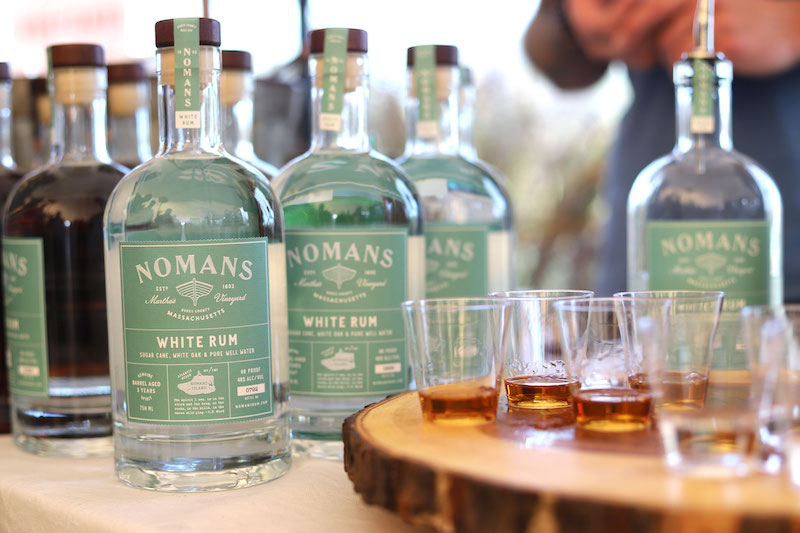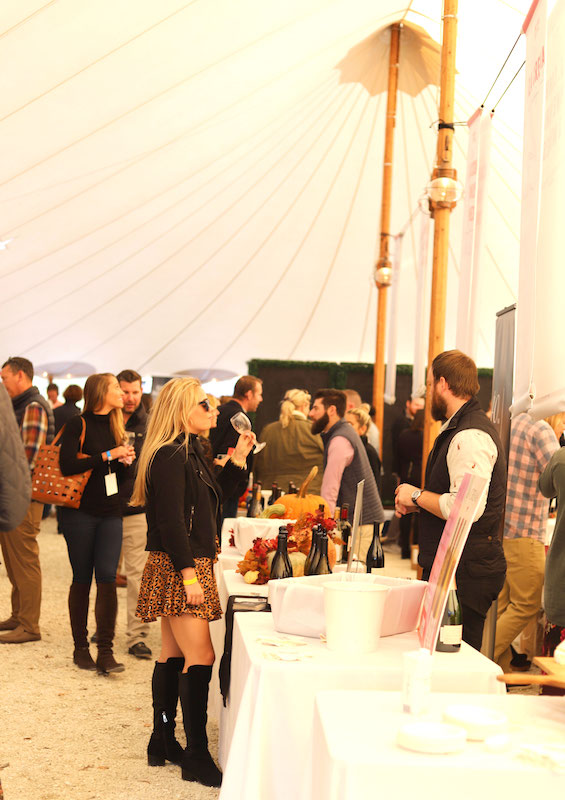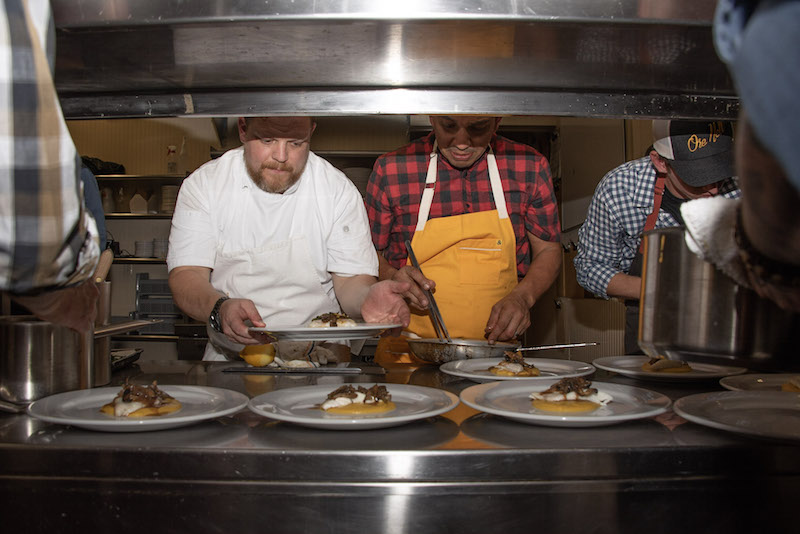One glass. 250 wines. Pick up a steak tartar chicharron when you pass “go.”
Those were the three rules at the Grand Tasting on Saturday, the signature event of the Martha’s Vineyard Food and Wine Festival. Sprawled over three tents at the Winnetu resort in Katama, the tasting packed the Vineyard full of real vineyards, with wineries and restaurants from across the country — and world — offering up bottomless vintages and endless finger foods to the oenophile masses.
By 2 p.m., a line hundreds of people long snaked outside the tents. By 2:30, that line had made its way inside, moving through the booths with hands full and mouths fuller. Some had strategy, seeking out a new Cabernet or only offering their glasses to wineries from France. Others were less systematic, simply ecstatic to have something in their glass, be it a Sauvignon Blanc or brisket pate.
Alina Zarr, who started the Land of Promise Vineyard in Sonoma with her family offered Pinot Noir at the front of the tent. She planted the grapes with her father, who came to the United States from Kazakhstan when it was part of the former Soviet Union.
“It’s called Land of Promise because we are an immigrant family,” Ms. Zarr said.
Others emigrated to learn winemaking. Jared Brandt started Donkey and Goat wine after moving to France on a lark. The name came from his French neighbor, who used a donkey and goat to clear vines. They now have over 30 growing sites, with a winery in Berkeley, Calif.
Wine wasn’t the only offering. Japanese olive beef, Basque pepper cannolis, duck rillette, bone broth, lobster ravioli, leek soup, prosciutto from Genoa and salami from Tuscany all cleansed palettes. And Nomans, which has a restaurant in Oak Bluffs, was offering shots of dark rum, not yet available in stores.
For the most curious, Boston chefs offered live cooking demonstrations in the arts of Japanese and South American cuisine. They had to look no further than their neighboring tent to find something which with to pair the delicacies.

But the food and wine festival was not all about wine. On Friday night at Dos Mas in Oak Bluffs the signature spirit was tequila along with a taco bar, inspired by owners and brothers, Zared and Evan Shai.
“It’s a little bit different,” Zared acknowledged as he shook up a mix of their signature spicy Bloody Mary. “We’re just doing what we do.”
Zared and Evan did just that — serving up heaping portions of chicken, steak, cauliflower and mushroom tacos to be washed down with a strong kick of various tequilas.
The Shai brothers also own and operate the Taco House (formerly Backyard Taco) in Edgartown. They plan to keep Dos Mas open throughout the winter. Zared said he was proud to serve the Island community and excited to keep the tacos sizzling and tequila pouring throughout the offseason.
“The combination just makes sense,” he said.
David Ravandi, CEO and master distiller for 123 Organic Tequila, one of the liquor vendors for Dos Mas and many other Island restaurants, agreed.
“Everything goes well with tequila,” he said. “Everything.”
And, it turned out, everything goes well with food and drink of any kind during a signature fall weekend on the Vineyard that saw most of the food and wine festival events sell out.
On Friday Daniel Boulud cooked a five-course French dinner, plus there was a Lobsterpalooza, a primer on Italian salumi, a master class on day drinking and brunch run for the truly hardy.
At Atria on Friday night there was a Know Fish dinner that paired wine and seafood with discussions of sustainability. Chefs for the dinner hailed from Portsmouth, N.H. “A nice little seafood hub just south of Portland and just north of Gloucester,” said chef Noah Kincaide.
And though the chefs were imported from off-Island, the seafood was as local as can be, with plates of Katama oysters and freshly caught tautog, tuna and fluke, in addition to Island-grown vegetables.
The theme of the night was celebrating sustainably caught seafood across the northern Atlantic seaboard along with the people who catch it, and educating the people who eat it.
“We call it the Know Fish Dinner and that’s kind of a double-entendre,” said chef Brendan Vesey. “If we’re not careful about what we’re eating, and how we’re catching it, we might not have any fish.”
He continued: “So we have to be able to know our fish and know our fishermen. A lot of the towns along the seaboard that we go to, just like this one, wouldn’t be the same without their fishing industries.”
On Saturday, a Japanese dinner at Bettini restaurant at the Harbor View Hotel celebrated the country’s varied cuisine in five courses, each inspired by a different region of Japan. Harbor View executive chef Patrice Martineau described each course, telling diners that his experience cooking at the Peninsula Hotel in Tokyo was transformative for him. The dinner also featured five different Japanese sakes and wines from around the world.
And there were more local events, like the one that kicked off the long weekend on Wednesday at the Agricultural Hall featuring Island chefs serving Island cuisine, and a lively Thursday afternoon talk at the Harbor View with New York Times Food editor Sam Sifton.
The theme continued at the Oh Shucks event held just before the grand tasting ceremony on Saturday, where a small crowd gathered at the top floor of the Winnetu to pair local oysters with Iberian peninsula wine.
“The wine component varies each year depending on where I’ve traveled,” said co-founder of the Food and Wine Festival Dan Michaud. “The oysters are the constant.”
The oysters for the past three years have been provided by Cottage City Oysters, raised in Oak Bluffs by brothers Dan and Greg Martino.
“They are the most sustainable protein on earth,” Dan told the crowd of oyster lovers. “They are filter cleaners. They take nothing and only help the environment.”
Mr. Michaud explained that much like wine, oysters all come from the same genus of seed. What gives them a variety in profile is how they are raised and the type of water that they are raised in. “Just like wine. . . oysters have become an important part of our culture and history in this part of the century.”










Comments
Comment policy »